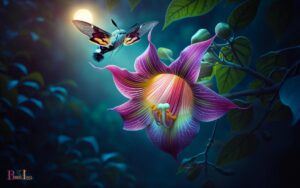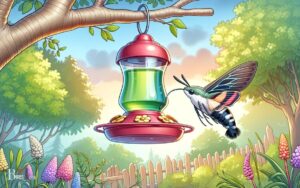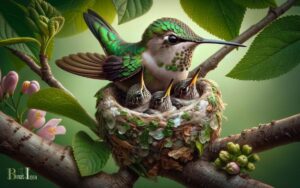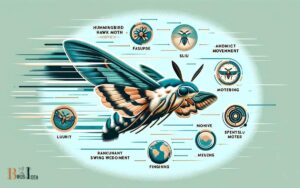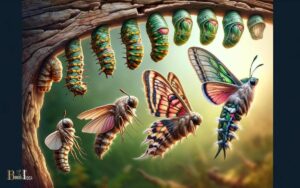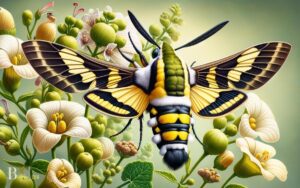What Does a Hummingbird Moth Look Like: Discover!
The Hummingbird Moth, often mistaken for the bird it’s named after, is actually an insect with unique characteristics.
It is known for its bird-like hovering behavior, buzzing sounds, and long proboscis used for feeding.
This moth has a stout, furry body, clear or opaque wings that beat rapidly, and distinctive markings that can include stripes or spots.
They vary in color but are commonly found with shades of green, brown, red, or pink on their bodies.
Hummingbird moths belong to the Sphingidae family and are known for their remarkable resemblance to hummingbirds. They display many bird-like behaviors, such as hovering in front of flowers to drink nectar.
They are distinguishable by features such as:
These characteristics make the hummingbird moth a unique and captivating species to observe.
The hummingbird moth is a delightful mimic of the hummingbird, showcasing nature’s artistry in insect form.
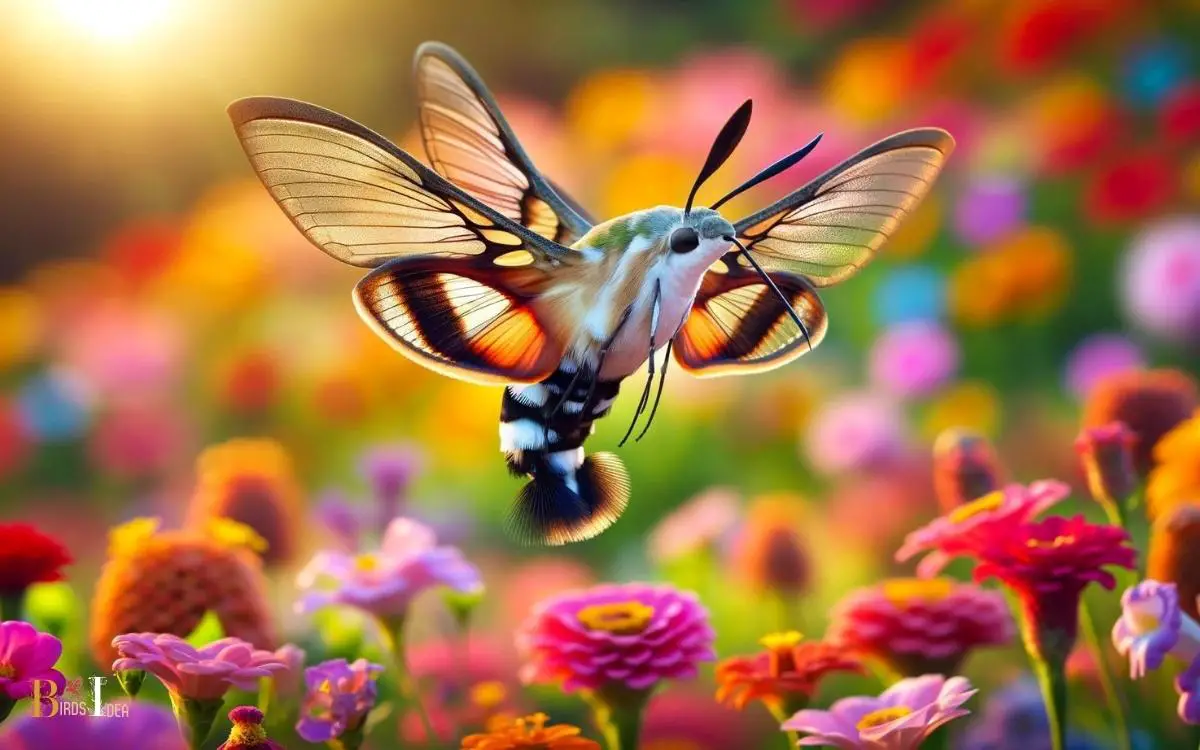
Key Takeaway
Common Characteristics of Hummingbird Moth
| Characteristic | Description |
|---|---|
| Order | Lepidoptera |
| Family | Sphingidae |
| Body Appearance | Stout and furry, resembling a small bird |
| Proboscis | Long and coiled, used for feeding on nectar |
| Wing Appearance | Clear or opaque, with rapid movement |
| Wing Span | Typically 4 to 5.5 centimeters |
| Sounds | Humming noise from rapid wingbeats |
| Color Variations | Commonly green, brown, red, or pink |
| Markings | Stripes or spots, varying by species |
Physical Characteristics
The hummingbird moth has a slender body, narrow wings, and a long proboscis for feeding on nectar. Its body is typically brown, tan, or olive green, often with a striped or banded pattern.
The wings are transparent with a reddish or brown border, and they beat rapidly, much like those of a hummingbird.
This allows the moth to hover in front of flowers while feeding, giving the appearance of a small hummingbird.
Its long proboscis, which is used to extract nectar from flowers, can be as long as its body. This distinguishing feature sets it apart from actual hummingbirds.
Wing Structure
With a distinctive wing structure, the hummingbird moth exhibits a transparent, rapid-beating wing pattern that resembles that of a hummingbird.
The wings are mostly clear with a black or dark brown border and veins, contributing to their resemblance to a hummingbird’s wings.
The moth’s wingspan typically ranges from 1 to 2 inches, allowing for agile and precise flight. The moth’s ability to hover in mid-air and move swiftly from flower to flower is facilitated by its unique wing structure.
The following table outlines the key features of the hummingbird moth’s wing structure:
| Wing Structure Features | Description |
|---|---|
| Transparency | Clear wings with dark borders and veins |
| Size | 1 to 2 inches wingspan |
| Flexibility | Allows for agile flight and hovering ability |
| Resemblance | Similar to a hummingbird’s wing pattern |
The hummingbird moth’s remarkable wing structure is complemented by its coloration and markings, which further enhance its unique appearance in the natural world.
Coloration and Markings
Exhibiting vibrant colors and distinctive markings, the hummingbird moth’s appearance further captivates observers as it flits from flower to flower. With this striking coloration, the moth easily stands out amidst the surrounding foliage.
The wings of the hummingbird moth are typically transparent or translucent, often with a reddish or brownish hue, and are marked with dark bands or patches.
Its body is adorned with varying shades of brown, black, and white, often resembling the intricate patterns found on true hummingbirds. These markings not only contribute to its beauty but also aid in camouflage and protection.
The combination of its coloration and markings allows the hummingbird moth to mimic a hummingbird’s appearance, adding to the fascination of its behavior and movement.
Transitioning to the subsequent section about ‘body size and shape’, the physical characteristics of the hummingbird moth contribute to its remarkable resemblance to its avian namesake.
Body Size and Shape
Sporting a slender, elongated body and narrow wings, the hummingbird moth possesses a distinctive shape that mirrors its avian namesake.
To paint a clearer picture of the hummingbird moth’s body size and shape, consider the following:
- Body: The moth’s body can measure around 2 inches in length, with a narrow, streamlined profile resembling a miniature hummingbird.
- Wings: Its wingspan can reach up to 2.5 inches, showcasing transparent wings with a rapid fluttering motion, similar to a hummingbird’s wings.
- Abdomen: The abdomen is elongated and tapers to a point, aiding in agile flight and precise hovering while feeding.
- Thorax: The thorax, where the wings and legs are attached, is relatively large compared to the body, providing the necessary power for its distinctive flight pattern.
Understanding these features helps in identifying and appreciating the unique body size and shape of the hummingbird moth.
Flight Behavior
The hummingbird moth mesmerizes observers with its agile flight behavior, darting from flower to flower with remarkable precision and speed. It hovers effortlessly, using its rapid wingbeats to stay in one place while it feeds on nectar.
This moth is capable of flying backward, just like a hummingbird, which adds to its enchanting display of aerial abilities.
Its flight pattern is characterized by sudden shifts in direction, allowing it to navigate through dense foliage with ease.
The moth’s wings create an audible humming sound as it darts around, adding to the impression of a tiny hummingbird.
Its flight behavior is a remarkable adaptation that enables it to efficiently forage for nectar while evading predators, making it a captivating sight to behold in gardens and meadows.
Feeding Habits
With an insatiable appetite, the hummingbird moth sips nectar through its long proboscis, and it’s particularly drawn to tubular, fragrant flowers.
When feeding, the moth exhibits fascinating behaviors:
- Hovering: It hovers in front of the flower, using its wings to maintain a stationary position while it feeds.
- Proboscis insertion: The long, straw-like proboscis is inserted into the flower to reach the nectar at the base of the bloom.
- Continuous feeding: The moth drinks nectar continuously, rarely staying at one flower for more than a few seconds.
- Pollination: As it moves from flower to flower, the hummingbird moth inadvertently transfers pollen, aiding in the pollination of various plant species.
These feeding habits make the hummingbird moth an important pollinator in many ecosystems.
Habitat and Range
Characterized by a wide distribution across various habitats, the hummingbird moth displays a remarkable adaptability to different environments.
These fascinating insects can be found in diverse settings such as gardens, meadows, fields, and woodland edges.
They’re commonly seen in North America, Europe, and Asia, showing their ability to thrive in temperate and tropical regions.
Hummingbird moths are also known to inhabit areas with flowering plants, as they rely on these nectar sources for sustenance.
Their range extends from sea level to mountainous regions, showcasing their resilience to different altitudes.
The adaptable nature of the hummingbird moth allows it to flourish in a variety of ecosystems, making it a unique and intriguing species to observe in the wild.
What Does a Hummingbird Moth Look Like Before It Turns Into a Cocoon?
Before undergoing metamorphosis, you can discover the hummingbird moth cocoon in its larval stage. The larva resembles a plump, cylindrical caterpillar with green or brown coloration and white, lateral stripes. As it prepares to transform, it will seek a safe location and spin a silken cocoon to pupate within.
Mimicry and Adaptations
Adaptation plays a crucial role in the survival of the hummingbird moth, allowing it to mimic its avian namesake and thrive in diverse environments.
Here’s how the hummingbird moth achieves this:
- Body Shape: The moth’s streamlined body closely resembles that of a hummingbird, enabling efficient flight and maneuverability.
- Coloration: With its brown and orange hues, the moth’s coloring closely resembles that of a hummingbird, providing camouflage and protection from predators.
- Feeding Behavior: Like hummingbirds, the moth feeds on nectar from flowers using a long proboscis, allowing it to access deep floral tubes.
- Flight Pattern: The moth hovers mid-air while feeding, just like a hummingbird, thanks to its rapid wingbeats, further enhancing its avian mimicry.
These adaptations enable the hummingbird moth to thrive in a variety of ecosystems, ensuring its survival.
Conclusion
The hummingbird moth is a fascinating creature with its unique physical characteristics, impressive wing structure, and vibrant coloration.
Its ability to mimic a hummingbird’s behavior and adapt to different environments makes it a true ‘jack of all trades’ in the insect world.
With its swift flight and efficient feeding habits, the hummingbird moth is a sight to behold for anyone lucky enough to spot one in the wild.

